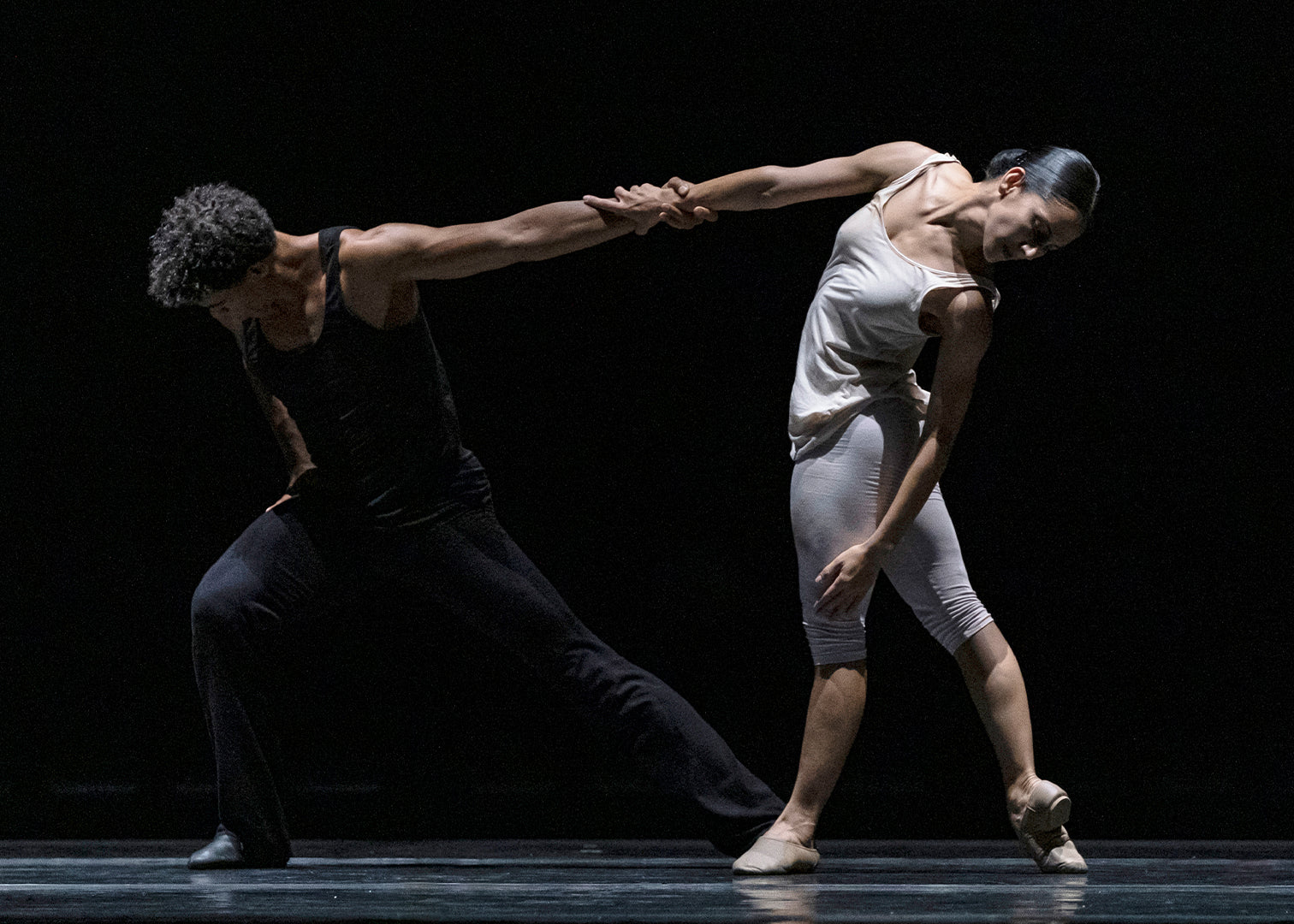Jones, who has created more than 140 works for his troupe, the Bill T. Jones/Arnie Zane Dance Company, founded in 1982, continues to make art that stimulates, challenges and never shies away from the human condition and its attendant emotional realities, however somber, tortured or exhilarating.
No longer dancing himself, in his 2012 work, “Story/Time,” Jones, nevertheless takes center stage. With his mellifluous baritone voice and still commanding presence, this African-American son of the South, reads his own short stories while seated at a desk whose décor is a glass of water, a tiny light, and a row of green Granny Smith apples, the fruit mirroring the neon green of a large digital clock looming above and behind Jones, punctuating the inexorable, fleeting passage of time. (The clock disappears at around the 16-minute mark, returning near the work’s end.)
Inspired by a 1958 John Cage project/lecture, “Indeterminacy” (90 stories in as many minutes), the work is also an homage to the late composer and his partner, Merce Cunningham, who, in their stunningly inventive, “How to Pass, Kick, Fall and Run” from 1965—a mind-bogglingly half-century old—made use of chance procedures to determine the order of the program.
Jones, a born raconteur (his book, Story/Time: The Life of an Idea, was published last year by Princeton Press), is a 21st century griot, his eight dancers beautifully illustrating these anecdotes, though mostly not, thankfully, in a literal fashion. After all, that would be somewhat anti-Jones, who has often wrestled with narrative versus abstract dance in his prodigious career, stating in the Q & A afterwards that he believes television—and programs such as Showtime’s Ray Donovan—is now the Golden Age of storytelling.
With composer Ted Coffey’s live electronic score (also determined by chance, a model of the I Ching part of his sonic set-up), rife with industrial noise, silence, smidgens of song and a delicious recurring chimes motif, the multi-layered “Story” is both a visceral and highly cerebral experience.
Of the 190 minute-long vignettes Jones has written, roughly 70 are read at any given performance. Tales range from the personal (stories of his mother, his late partner, Zane, who died in 1988 at 39), to anecdotes of gardening, art world gossip and a mini-treatise on quantum particles.
Akin to channel surfing (if you don’t like one story, have no fear, another will soon be delivered), watching the work also yields a bit of whimsy: Who knew that the 17th Earl of Oxford, Edward de Vere, suffered a moment of flatulence while being presented to Queen Elizabeth I? Jones did and now, so do we.
Moving from one non sequitur yarn to another with ease, Jones also wove in a celebrity pleasantry involving his mother, Estella. Not recognizing the actor Anjelica Huston, who had asked her about visiting her church, Mother Jones replied: “We accept all kinds.”
The dancers, portraits of ebullience, nonchalance, stamina and heartbreaking beauty, are dressed in Liz Prince’s costume designs. First clad in yoga wear, then floral dresses and bold colored-pants for the men, the octet returns to sweats and hoodies in a brief, hip-hop interlude that has been incorporated into a new Jones work, “A Letter To My Nephew/Pretty” (the guy is nothing if not prolific), which premieres in France next month.
There is also a tasteful scene featuring full nudity (Erick Montes-Chavero and Jenna Riegel), played out on a darkened stage, courtesy of Robert Wierzel’s evocative lighting design.
Time is passing: We see it—in the clock, on the dancers’ bodies, in Jones’ all-over-the-map but seriously focused narratives—and we receive these moments, fully engaged. As a society hungering for expression beyond the Selfie, we—at least some of us—need such kinetic slices of life overlaid and mingled with strong drama, the meld of words and movement sometimes competing against one another, yet, for the most part, the sum of these parts enhancing the whole.
Creative director Bjorn Amelan’s set design also includes transparent, movable white scrims and a black sofa and large chair, which Jones later explained represented therapy and dealing with his own depression, these shifting of boundaries and relationships metaphorically expanding the mini-serialized drama. Jones also pointed out that the floor’s 12 squares served as rooms in his “palace of memory.”
When so much of today’s lives are represented in 140 characters (the Twitter effect has, like it or not, become inescapable), these short stories inhabit a parallel universe, ping-ponging through the personal, the urbane, the biblical and the quirky. Jones’ dancers embody spoken word through angled arms and legs, couples’ intense but brief proddings/releasings, and dimly lit tableaux, frozen scenes reminiscent of the lonely, stark cosmos of Edward Hopper.
The audience, voyeurs all, is invited to live vicariously through this journey of an artist continually seeking higher truths. We learn that Jones’ father, Gus, often told his son, “You live and you learn,” before adding, “You die, and you forget it all.” After Gus died, Jones then revealed how his mother, prostrate with grief, “threw herself on the floor,” rolling back and forth in a hallway.
Here, too, the dancers rolled across the stage, swirls of smoke emanating from their clothes: Death is fiery, hellish, inevitable. Other moments featured the hard-working terpsichores, including Antonio Brown, Rena Butler, Cain Coleman, Jr., Talli Jackson, Shayla-Vie Jenkins and I-Ling Liu, lunging, leaping and pirouetting, their ballet training an ideal complement to Jones’ distinct vocabulary—determined one-legged balances, arched backs and articulated footwork beautifully on display in randomly configured solos, duets, quartets, and ensembles.
An astute chronicler of life, Jones has never fully forsaken narrative, his dance-theater works including the 2009 masterpiece, “Fondly Do We Hope…Fervently Do we Pray,” which recounts pivotal moments in the life of Abraham Lincoln (as, perhaps, put through the Cuisinart of Jones’ fertile mind).
With “Story/Time” an excursion into a vast array of universes—physical, psychological, emotional—Jones remains the ever-brilliant nucleus around which his dedicated dancers orbit.









comments